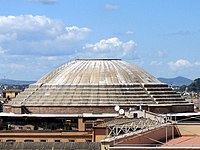
Photo from wikipedia
This article demonstrates the possibility of producing alkali-activated materials (AAM) from a mixture of mechanically processed concrete, ceramic, masonry, and mortar wastes, as a sustainable alternative for recycling construction and… Click to show full abstract
This article demonstrates the possibility of producing alkali-activated materials (AAM) from a mixture of mechanically processed concrete, ceramic, masonry, and mortar wastes, as a sustainable alternative for recycling construction and demolition wastes (CDWs) under real conditions. The addition of 10% Portland cement allowed the materials to cure at room temperature (25 °C). CDW binder achieved a compressive strength of up to 43.9 MPa and it was classified as a general use and low heat of hydration cement according to ASTM C1157. The concrete produced with this cement and the crushed aggregates also from CDW reported a compressive strength of 33.9 MPa at 28 days of curing and it was possible to produce a high-class structural block with 26.1 MPa according to ASTM C90. These results are considered one option in making full use of CDWs as binder and aggregates, using alkaline activation technology thereby meeting the zero-waste objective within the concept of the circular economy.
Journal Title: Sustainability
Year Published: 2020
Link to full text (if available)
Share on Social Media: Sign Up to like & get
recommendations!